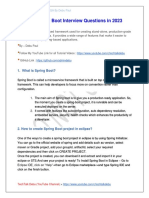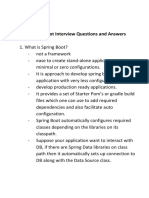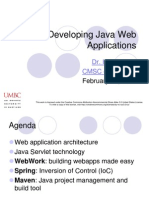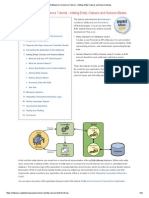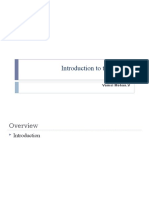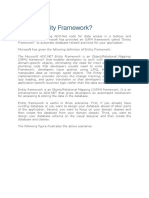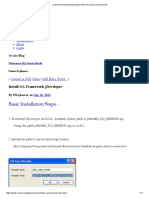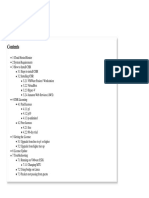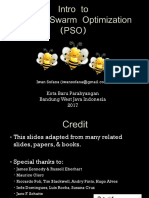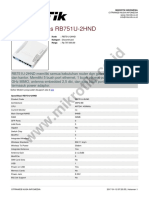Professional Documents
Culture Documents
Docs Huihoo Com Apache Ofbiz 2 1 1 OFBizQuickStart HTML
Docs Huihoo Com Apache Ofbiz 2 1 1 OFBizQuickStart HTML
Uploaded by
IwanOriginal Description:
Original Title
Copyright
Available Formats
Share this document
Did you find this document useful?
Is this content inappropriate?
Report this DocumentCopyright:
Available Formats
Docs Huihoo Com Apache Ofbiz 2 1 1 OFBizQuickStart HTML
Docs Huihoo Com Apache Ofbiz 2 1 1 OFBizQuickStart HTML
Uploaded by
IwanCopyright:
Available Formats
The Open For Business Project
Quick Start Guide
Brett G. Palmer
[email protected]
Updated January 20, 2003
Table of Contents
Introduction
Comparing OFBiz with Other Open Source Projects
Getting Started
Separating the Entity Engine from the Rest
Creating Your First Web Application
Conclusion
References
Introduction
The purpose of this document is to assist people interested in the Open For Business (OFBiz) project to get started as quickly as possible. I have been using the OFBiz framework for a few
months now and have found it to be very helpful in building Java based web applications. There are a lot of components that can significantly reduce the cost of your project. Unfortunately,
like many open source products the documentation is fairly light. This document does not cover everything in detail but does provide some helpful tips to help you started. This Quick Start
document will cover the following topics:
Comparing OFBiz with other projects
Using the Entity engine
Creating web applications through the web controller
Comparing Ofbiz with Other Open Source Projects
If you found OFBiz chances are you have seen several other open source projects. What makes OFBiz different than most of these projects is that OFBiz is an entire framework of
components and tools to help develop web applications in Java. A good web application is broken down into different logical layers. There is a web or presentation layer, a business logic
layer, and a database or persistent layer. Frameworks such as Struts, Cocoon, and Velocity focus primarily on the web tier. Struts for example, follows a model-view-controller (MVC)
architecture for combining JSP pages with Java Beans or Action classes as they are called. Struts is a very good framework for building web applications but it does not provide components
for accessing databases or controlling workflow. These components you are expected to build yourself. This is where OFBiz differs from many other open source Java projects. If you’re
already working with another Java framework such as Struts you could easily include some of the OFBiz components into your project.
Getting Started
The easiest way to get started with OFBiz is to download the ofbiz-XX-XX-complete.zip version of the source. This is significantly bigger than the ofbiz-XX-XX-src.zip version because it
includes the entire download of Catalina (Tomcat 4.X), but if you can afford the download time it will be worth it. The complete version comes with several scripts (e.g. ofbiz.bat ) that will
start Catalina with the OFBiz components installed and running without any compiling. And if you have Jakarata Ant you will be able to build the source without modifying anything. This
will save you a lot of time at first. I wouldn’t recommend getting the source from CVS or the even downloading the "source only" version until you are more familiar with OFBiz and its
components. Otherwise you will spend a considerable amount of time setting up classpaths and configuration files.
Requirements:
1. Apache's Ant 1.5 (I have also used 1.4.1 without any problem)
2. ofbiz-XXX-XXX-complete.zip or ofbiz-XXX-XXX-complete.tgz
3. JDK 1.3.x. I was able to run OFBiz with JDK 1.4 but compiling gave me several deprecation warnings.
Recommendations:
1. Learn the Entity Engine
2. Create a small web application
Separating the Entity Engine from Other Components
Getting the sample applications (e.g. E-commerce application) up and running is fairly straightforward, but working with the components separately can be difficult but not impossible. The
difficult part is learning how to configure the components independently from the other components. This section demonstrates how the OFBiz entity engine can be configured and tested
separately from the other components. Working with individual OFBiz components can help you learn more quickly the OFBiz framework.
OFBiz's entity engine is one of the most mature components and I think one of its greatest assets. Writing persistent layer code in JDBC may not be that difficult but it can take a lot of time
and is error prone. OFBiz's entity engine can greatly simplify writing database components and lets you focus on the business logic of the application.
A good strategy for working with the OFBiz entity engine is to create your own JUnit tests that verify that your entity definitions are setup and working correctly. I like the Extreme
Programming (XP) philosophy of code a little, test a little, etc. This is also a good method for maintaining and testing your code base. This is not a tutorial on JUnit for more information
JUnit see the references section below. I have found this to be a good way to work with the OFBiz entity engine components.
Key Files:
entityengine.xml - defines your database delegator and entity definitions to include in your project.
entitygroup.xml - works alongside the entityengine.xml file to group entity definitions into specific group
entity_<your_entity_defs>.xml - your own custom entity definition file
Configuration Steps
Here are some steps you can use to help you understand how to configure the OFBiz entity engine. I use JBuilder 5.0 Professional for my development. Some of my examples will be specific
to JBuilder, but you should be able extract the necessary information for you development environment.
1. Define your own entity definition and place it in the <OFBIZ_HOME>\commonapp\entitydefs directory. For example, if I was building a online bookstore I might have a entity definition file entitymodel_bookstore.xml. For
specific examples of entity definitions look at the entitymodel_order.xml and entitymodel_product.xml definitions that are part of the OFBiz E-commerce application.
2. Modify the entityengine.xml file in the <OFBIZ_HOME>\commonapp\etc directory. You need to include your own entity definition in the entityengine.xml file. Here is an example of how this could be entered for step1 above.
<entity-model-reader name="main">
<resource loader="mainfile" location="entitymodel.xml"/>
<resource loader="mainfile" location="entitymodel_bookstore.xml"/>
</entity-model-reader>
3. Define your datasource(s) in the entityengine.xml file. You access your entities through a GenericDelegator. The delegators are specified in the entityengine.xml file. You can have multiple delegators and multiple datasources
defined in the entityengine.xml file. Here is an example of a delegator and datasource configuration.
<delegator name="default" entity-model-reader="main" entity-group-reader="main">
<group-map group-name="org.ofbiz.commonapp" datasource-name="localhsql"/>
<group-map group-name="com.mybookstore.bookstore" datasource-name="other_datasource"/>
</delegator>
<datasource name="localhsql"
helper-class="org.ofbiz.core.entity.GenericHelperDAO"
field-type-name="hsql"
check-on-start="true"
add-missing-on-start="true";
use-foreign-keys="true";
use-foreign-keys-indices="true";
use-fk-initially-deferred="false";
join-style="theta-oracle">
<sql-load-path path="commonapp/db" prepend-env="ofbiz.home"/>
<sql-load-path path="ecommerce/etc" prepend-env="ofbiz.home"/>
<inline-jdbc
jdbc-driver="org.hsqldb.jdbcDriver"
jdbc-uri="jdbc:hsqldb:../../data/ofbiz"
jdbc-username="sa"
jdbc-password=""
isolation-level="ReadUncommitted"/>
<!-- <jndi-jdbc jndi-server-name="localjndi" jndi-name="java:/HsqlDataSource"/> -->
</datasource>
This delegator example uses the OFBiz 'default' delegator. The example demonstrates how you can use 'group-maps' to group components into different data sources. In this example all of the org.ofbiz.commonapp components use the
localhsql (hypersonic database) and the com.mybookstore.bookstore components use the 'other_datasource' data source. This feature let you use different databases from a single delegator.
4. Modify the entitygroup.xml file in the <OFBIZ_HOME>\commonapp\entitydef directory. This is important point that I often forget when setting up new entity definitions. If you forget to include new entity definitions in the
entitygroup.xml file you entities will not be dynamically created when you start the delegator. And any code that tries to access these entities will fail.
<!-- ========================================================= -->
<! - Bookstore Entities -->
<!-- ========================================================= -->
<entity-group group="com.mybookstore.bookstore" entity="Store" />
<entity-group group="com.mybookstore.bookstore" entity="Books" />
<entity-group group="com.mybookstore.bookstore " entity="Authors" />
In the above example, I have defined three entities that are included in the entitymodel_bookstore.xml. Note also that these entities belong to the group com.mybookstore.bookstore which we defined in the entityengine.xml in step 3.
This means the entity tables for Store, Books, and Authors will be found in the 'other_datasource' configuration.
JBuilder Setup
Steps 5 through 8 describe how to setup an OFBiz entity project in JBuilder. Your development environment may be different but hopefully you can extract the necessary information to get an
OFBiz entity project setup in your Java IDE. I like to use a combination of an IDE for source level debugging and the OFBiz Ant scripts to build, setup, and deploy the entire web application.
For this reason I keep the configuration files in the same location for both development environments.
5. Setup you source paths in your JBuilder project. If your project just involves the entity engine then the minimal source paths you will need are the following:
<OFBIZ_HOME>\core\src\entity
<OFBIZ_HOME>\core\src\share
Any of you own source directories
You can add other source directories to your project as you need them.
6. Add the necessary libraries to compile your project. To avoid conflicts with the JBuilder build and the OFBiz Ant builds I only include the libraries necessary to build the source. You could build all the OFBiz libraries and
include them in your project but then when you try to build using Ant you have to close JBuilder since it has the libraries open. The necessary Jar files can be found in the following directories:
<OFBIZ_HOME>\lib\compile
<OFBIZ_HOME>\lib\common
<OFBIZ_HOME>\lib\share
7. To run a test against your entity engine configuration you need to setup some environment variables within JBuilder. Many of the OFBiz components work from the relative path of the ofbiz.home environment variable. You can
specify this environment variable in the Projects Run tab under the category VM parameters (e.g. '-Dofbiz.home=c:\ofbiz\ofbiz')
8. There are some other files that need to be in your classpath for the entity engine to function properly. JBuilder seems to only allow directories or Jar files to be added to a classpath. To work around this limitation I created Jar
files for the specific files that I needed. Then I added these Jar files to my project like the other libraries I added in step 6. Note: this is only a problem in running the entity engine from within JBuilder. The OFBiz Ant builds put
all the files in their appropriate Jar files during deployment. The files that you need are the entityengine.xml and the DTD files that define XML schemas. These can be found in the following directories:
<OFBIZ_HOME>\commonapp\etc - contains the entityengine.xml file
<OFBIZ_HOME>\core\docs\xmldefs\ofbiz - contains all the DTD files for the OFBiz components.
For the etc directory I create the jar file as follows:
jar cvf ofbiz_etc.jar *.xml
And for the DTD files I include all of them with the command:
jar cvf ofbiz_dtd.jar *
9. It should be noted that the OFBiz Ant build puts all the DTD files in the core/lib/ofbcore-share.jar file which you could use except you will get conflicts when you try to build with Ant while having JBuilder running.
10. Create your JUnit test to validate your entity definitions. Here is an example of a method that validates my entity code:
public void testFindByPrimaryKey() {
try {
Debug.logInfo("Entered testFindByPrimaryKey");
//Instantiate the delegator.
GenericDelegator delegator = GenericDelegator.getGenericDelegator("default");
assertNotNull("Error creating delegator object", delegator);
//Create an Book Entity
String bookId = delegator.getNextSeqId("Book").toString();
GenericValue bookValue = delegator.makeValue("Book",
UtilMisc.toMap("bookId", bookId,
"author", "Joe Smith',
"name", "My Favorite Book",
"publisher", "Some Publisher"));
GenericValue book = delegator.create(bookValue);
assertNotNull("Couldn't create Book entity", book);
// Find book by primary key
GenericValue foundBook = delegator.findByPrimaryKey("Book",
UtilMisc.toMap("bookId", bookId));
assertNotNull("Couldn't find Book: " + bookId, foundBook);
Creating Your First Web Application
Again the easiest way to learn OFBiz is to start using it and the easiest way to learn the OFBiz web controller is to use one existing web application that is already setup. For example in the
<OFBIZ_HOME> directory there is a ecommerce, ordermgr, workeffort, and webtools application. Each of the projects includes a webapps directory where all the JSP and control files
exists. You need to become familiar with the following files when dealing with the web controller. .
Key Files:
<CATALINA_HOME>\conf\server.xml - contains the context settings for your OFBiz web applications when Catalina is started.
controller.xml - OFBiz's web controller configuration file that is contained in each applications WEB-INF directory.
regions.xml - file to organize JSP pages into different sections of an HTML page. This allows you to create custom header, footer, sidebars, and menus and share them across several
JSP pages. This file is also located in the applications WEB-INF directory for each application.
Here are some steps you can take to quickly get a web application working in OFBiz:
1. Copy an existing OFBiz application to a start a new web application and change the name to your application. For example, you could copy the existing ecommerce directory and create
a new directory called 'bookstore'. Later you will have to remove some of the directories in the webapps directory that you won’t be using,. Now you have a working skeleton of files
and directories that adhere to the OFBiz development environment and you can start making changes to this new application without breaking the existing applications that come with
OFBiz.
2. Modify catalina's server.xml file to include the new application. Since the OFBiz applications are not contained in catalina’s default webapps directory (i.e.
<CATALINA_HOME\webapps) you need to add a new 'context' entry in catalina’s server.xml file as follows:
<Context path="/your_webapp" docBase="../../ofbiz/your_webapp/webapp"
debug="0" reloadable="true">
<Logger className="org.apache.catalina.logger.FileLogger"
prefix="your_webapp_log." suffix=".txt" timestamp="true"/>
</Context>
3. Create a link to a service that you can access from your browser. This is done by making an entry in the controller.xml file in your applications WEB-INF directory. Here is an example
of an entry.
<request-map uri="listbooks"><security https="true" auth="false"/>
<event type="java" path="com.mybookstore.books.BookEvents" invoke="listBooks"/>
<response name="success" type="view" value="listbooks"/>
<response name="error" type="view" value="error"/>
</request-map>
<view-map name="listbooks" type="region"/>
Assuming the default context for my application is 'bookstore', you would access the above URI by putting in http://localhost:8080\bookstore\control\listbooks in your browser if you
were running Catalina locally. The OFBiz web controller would then execute the method 'listBooks' in the BookEvents class. If the listBooks method returned the string 'success' the
controller would pass the response to a 'view' called 'listbooks.' If an error occurred the controller would pass the response to the 'error' view. Views in OFBiz are mapped to a region.
Regions are specified in the regions.xml file explained in step 4. The example shows a Java event but there are other event types that you can use. See the OFBiz documents for more
details on the other event services that are available.
4. Create the appropriate responses and views for the new service. Views let you combine JSP pages into a single HTML page. This lets you create headers, footers, menus, etc. The
ecommerce application has lots of example such as a dynamic shopping cart that displays your current purchases while you are browsing other merchandise. The view is the final
format of the response of your request. Here an example of a view definition for 'listbooks' that was shown in step 3.
<define id='listbooks' region='LEFT_ONLY_REGION'>
<put section='title'>List of Books</put>
<put section='content' content='/books/listbooks.jsp'/>
</define>
<define id='LEFT_ONLY_REGION' region='MAIN_REGION'>
<put section='leftbar' content='LEFTBAR_REGION'/>
</define>
<define id='LEFTBAR_REGION' template='/templates/leftbar_template.jsp'>
<put section='first' content='/menus/adminmenu.jsp'/>
<put section='second' content='/menus/customermenu.jsp'/>
</define>
5. Remove links that are not part of the new application. Since you copied an existing application to get started once you get familiar with how the web controller works you will won’t to
clean up the irrelevant links and files.
6. Continue to learn and develop new services that are available from OFBiz. This example only touched on a simple Java event. There are other event types that can be used as well as a
rules and workflow engine. Once you get familiar with the basics of OFBiz you should start investigating many of the other features of OFBiz.
Conclusion
This document provides some tips for starting with OFBiz. There are many other topics that are not covered in this document. If you find errors in this document please forward them to me
and I will make the corrections. Also, if there are other tips or helps you would like included in this document please let me know. The OFBiz project has many components that you can
include in your project. Some of these components include a rules engine, workflow engine, and simple languages. Future 'Quick Tips' documents on these topics will be forth coming.
References
Open For Business Project: www.ofbiz.org
Ant: http://jakarta.apache.org/ant/index.html
JUnit: www.junit.org
Struts: http://jakarta.apache.org/struts/index.html
Cocoon: http://xml.apache.org/cocoon/index.html
Velocity: http://jakarta.apache.org/velocity/index.html
You might also like
- Top 85+ Spring Boot QA For 2023 Java DeveloperDocument44 pagesTop 85+ Spring Boot QA For 2023 Java DeveloperAsgNo ratings yet
- 4.2.1 Packet Tracer - Troubleshoot EIGRP For IPv4 - ITExamAnswersDocument2 pages4.2.1 Packet Tracer - Troubleshoot EIGRP For IPv4 - ITExamAnswersIwanNo ratings yet
- Oracle Apps Technical Materialdoc PDF FreeDocument336 pagesOracle Apps Technical Materialdoc PDF Freeherculean2010No ratings yet
- IBM Control Desk - Project - Configure - V 7.6Document152 pagesIBM Control Desk - Project - Configure - V 7.6Lisa JonesNo ratings yet
- Springboot Interview QuestionsDocument151 pagesSpringboot Interview QuestionsReddy Kumar100% (1)
- Building Your First Laravel ApplicationDocument38 pagesBuilding Your First Laravel ApplicationsuyonoNo ratings yet
- Building Your First Laravel ApplicationDocument38 pagesBuilding Your First Laravel ApplicationGabriel RomanNo ratings yet
- spring boot basics (1)Document9 pagesspring boot basics (1)abdul MuqtadirNo ratings yet
- Building Your First Laravel ApplicationDocument38 pagesBuilding Your First Laravel ApplicationFrancesco MartinoNo ratings yet
- Introduction To The CodeIgniter PHP FrameworkDocument104 pagesIntroduction To The CodeIgniter PHP FrameworkNandakumar K Nair100% (1)
- How To Write Big Application in ExtjsDocument17 pagesHow To Write Big Application in ExtjsPrabhu Patil100% (1)
- 8 Tips To Be A More Efficient Asp Net DeveloperDocument6 pages8 Tips To Be A More Efficient Asp Net DeveloperandrysuryadNo ratings yet
- Applies To:: Modified 13-FEB-2008 Type HOWTO Status PUBLISHEDDocument14 pagesApplies To:: Modified 13-FEB-2008 Type HOWTO Status PUBLISHEDjaganktNo ratings yet
- Advanced Framework Transcription 20060824Document208 pagesAdvanced Framework Transcription 20060824kamalrajNo ratings yet
- Apache Ofbiz User ManualDocument1 pageApache Ofbiz User ManualIwanNo ratings yet
- Developing Java Web Applications 120276364738927 5Document45 pagesDeveloping Java Web Applications 120276364738927 5wafasaNo ratings yet
- SpringDocument26 pagesSpringSourabh JainNo ratings yet
- Technical Documents ProcessDocument9 pagesTechnical Documents Processapi-229102420No ratings yet
- Zend Framework Interview Question AnswersDocument10 pagesZend Framework Interview Question AnswersnutandevjoshiNo ratings yet
- AzureDocument146 pagesAzureEmerson Eduardo RodriguesNo ratings yet
- SAP Business Objects Interview Questions With AnswersDocument6 pagesSAP Business Objects Interview Questions With Answersscholarmaster0% (1)
- 11g Oracle SearchDocument39 pages11g Oracle Searchzuggo848592No ratings yet
- Fusion Order Demo (FOD) - Sample ADF ApplicationDocument2 pagesFusion Order Demo (FOD) - Sample ADF ApplicationValente Hernandez VazquezNo ratings yet
- SpringBoot-Training 1.0Document15 pagesSpringBoot-Training 1.0Syed Maqbul Hussain KotwalNo ratings yet
- Unit 2Document33 pagesUnit 2dharmavarapukarthikNo ratings yet
- 52 Tips & Tricks To Boost .NET PerformanceDocument66 pages52 Tips & Tricks To Boost .NET Performancev_doina20023873No ratings yet
- Setting Up Multiuser Development Environment (MUDE) Using Oracle BI Administration ToolDocument48 pagesSetting Up Multiuser Development Environment (MUDE) Using Oracle BI Administration ToolRachel MathewNo ratings yet
- Dabo PyCon 2010 TutorialDocument95 pagesDabo PyCon 2010 TutorialBoon DavidNo ratings yet
- 07 The NetBeans E-Commerce Tutorial - Adding Entity Classes and Session BeansDocument23 pages07 The NetBeans E-Commerce Tutorial - Adding Entity Classes and Session BeansJavier CaniparoliNo ratings yet
- Introduction To The Spring: Vamsi Mohan.VDocument27 pagesIntroduction To The Spring: Vamsi Mohan.VvamsitechnologyNo ratings yet
- Interview Questions For Oracle Apps DBADocument14 pagesInterview Questions For Oracle Apps DBAsivakrishnaNo ratings yet
- Course Notes For Unit 7 of The Udacity Course CS253 Web Application EngineeringDocument34 pagesCourse Notes For Unit 7 of The Udacity Course CS253 Web Application EngineeringIain McCullochNo ratings yet
- 10 Things You Can Do To Become A Better PHP DeveloperDocument15 pages10 Things You Can Do To Become A Better PHP DeveloperAlejandro NajarroNo ratings yet
- Ofbiz Tutorial - A Beginners Development Guide For 16.11: Overview (Introduction To Ofbiz)Document1 pageOfbiz Tutorial - A Beginners Development Guide For 16.11: Overview (Introduction To Ofbiz)IwanNo ratings yet
- Introducing To Spring BootDocument13 pagesIntroducing To Spring BootNiraj PandeyNo ratings yet
- Fashion Blog ReportDocument18 pagesFashion Blog ReportAshutosh mahaleNo ratings yet
- IS312 Week 11 Mini-Project RequirementsDocument2 pagesIS312 Week 11 Mini-Project RequirementsBrenda NandomahNo ratings yet
- WKBKCCB 05 BO Business RulesDocument11 pagesWKBKCCB 05 BO Business RulesLakshmiNarayana PuttamchettyNo ratings yet
- Azure FunctionsDocument146 pagesAzure Functionsjunk emailNo ratings yet
- Aspnet Core Web API Best Practices.03Document30 pagesAspnet Core Web API Best Practices.03Jhon Fredy Velasco VargasNo ratings yet
- Entity FrameworkDocument154 pagesEntity FrameworkraoNo ratings yet
- Security Testing With JMeterDocument11 pagesSecurity Testing With JMeterNguyễn ViệtNo ratings yet
- Add Search Features To Your Application - Try ElasticDocument15 pagesAdd Search Features To Your Application - Try ElasticrkpunjalNo ratings yet
- OAF Introduction: Learn Share ConnectDocument17 pagesOAF Introduction: Learn Share Connectshyam123gNo ratings yet
- OAF Interview QuestionsDocument43 pagesOAF Interview QuestionsRajeev NuniNo ratings yet
- Microsoft Team Foundation Server 2013Document6 pagesMicrosoft Team Foundation Server 2013goga1234No ratings yet
- Deploy To HerokuDocument31 pagesDeploy To HerokulelanaNo ratings yet
- RESTful Day 1 PDFDocument47 pagesRESTful Day 1 PDFenriqueNo ratings yet
- Why Using A Rule Engine ?: Discovering Jboss DroolsDocument8 pagesWhy Using A Rule Engine ?: Discovering Jboss DroolsteeloggerNo ratings yet
- The Ins and Outs of SAS® Data Integration StudioDocument16 pagesThe Ins and Outs of SAS® Data Integration StudioLemuel OrtegaNo ratings yet
- Ibatis TutorialDocument7 pagesIbatis TutorialSyed MohamedNo ratings yet
- Unit 5Document10 pagesUnit 5Mudit RajputNo ratings yet
- Basic Installation Steps : Blogs Home Products & Services Downloads Support Partners Communities About LoginDocument11 pagesBasic Installation Steps : Blogs Home Products & Services Downloads Support Partners Communities About LoginendalNo ratings yet
- Tìm hiểu GAE 01 - Building.High-PerfDocument41 pagesTìm hiểu GAE 01 - Building.High-PerfdolamthienNo ratings yet
- JSP 2 Struts Eclipse 3 DAO ANSI SQL DB and More With ExamplesDocument250 pagesJSP 2 Struts Eclipse 3 DAO ANSI SQL DB and More With Examplesapi-3696230No ratings yet
- Object-Oriented Programming: Paul HudsonDocument3 pagesObject-Oriented Programming: Paul HudsonKevin KaiguaraNo ratings yet
- Chris Olinger, D-Wise Technologies, Inc., Raleigh, NC Tim Weeks, SAS Institute, Inc., Cary, NCDocument20 pagesChris Olinger, D-Wise Technologies, Inc., Raleigh, NC Tim Weeks, SAS Institute, Inc., Cary, NCクマー ヴィーンNo ratings yet
- Beginning Database Programming Using ASP.NET Core 3: With MVC, Razor Pages, Web API, jQuery, Angular, SQL Server, and NoSQLFrom EverandBeginning Database Programming Using ASP.NET Core 3: With MVC, Razor Pages, Web API, jQuery, Angular, SQL Server, and NoSQLNo ratings yet
- Build Your First Web Site Today: EASYNOW Webs Series of Web Site Design, #1From EverandBuild Your First Web Site Today: EASYNOW Webs Series of Web Site Design, #1No ratings yet
- AgricolaeDocument89 pagesAgricolaeIwanNo ratings yet
- 102 Anova2Document4 pages102 Anova2IwanNo ratings yet
- Ofbiz Tutorial - Introduction For Developers: Auth "True"Document1 pageOfbiz Tutorial - Introduction For Developers: Auth "True"IwanNo ratings yet
- Xss - Cross-Site ScriptingDocument43 pagesXss - Cross-Site ScriptingIwanNo ratings yet
- 5.2.1 Packet Tracer - Configure Basic EIGRP With IPv6 Routing - ITExamAnswersDocument5 pages5.2.1 Packet Tracer - Configure Basic EIGRP With IPv6 Routing - ITExamAnswersIwanNo ratings yet
- C701, CEHv11-CEH 12 Study Guide Flashcards QuizletDocument62 pagesC701, CEHv11-CEH 12 Study Guide Flashcards QuizletIwanNo ratings yet
- How To Use Roles and Manage Permissions in PostgresqlDocument7 pagesHow To Use Roles and Manage Permissions in PostgresqlIwanNo ratings yet
- 2.2.1 Packet Tracer - Configure Basic EIGRP With IPv4 - ITExamAnswersDocument4 pages2.2.1 Packet Tracer - Configure Basic EIGRP With IPv4 - ITExamAnswersIwanNo ratings yet
- State of Apache OFBiz (PDFDrive)Document25 pagesState of Apache OFBiz (PDFDrive)IwanNo ratings yet
- Brief Explanation of Cybersecurity Using Deep LearningDocument28 pagesBrief Explanation of Cybersecurity Using Deep LearningIwanNo ratings yet
- Apache Ofbiz User ManualDocument1 pageApache Ofbiz User ManualIwanNo ratings yet
- Microsoft Word - Tutorial BGPDocument17 pagesMicrosoft Word - Tutorial BGPIwanNo ratings yet
- Arxiv 1809.02077 PDFDocument8 pagesArxiv 1809.02077 PDFIwanNo ratings yet
- Manual - CHR - MikroTik WikiDocument13 pagesManual - CHR - MikroTik WikiIwanNo ratings yet
- Training Machine Learning KNN 2017Document17 pagesTraining Machine Learning KNN 2017IwanNo ratings yet
- Modified PSO 64 PDFDocument5 pagesModified PSO 64 PDFIwanNo ratings yet
- PSO - Kota Baru Parahyangan 2017Document52 pagesPSO - Kota Baru Parahyangan 2017IwanNo ratings yet
- Manual Tutorial Dreamweaver 8 LengkapDocument4 pagesManual Tutorial Dreamweaver 8 LengkapIwanNo ratings yet
- Adobe Dreamweaver Cs3 TutorialDocument13 pagesAdobe Dreamweaver Cs3 TutorialabdulkusnanNo ratings yet
- WWW - Mikrotik.co - Id: Router Wireless RB751U-2HNDDocument2 pagesWWW - Mikrotik.co - Id: Router Wireless RB751U-2HNDIwanNo ratings yet
- (CVL) - BMS Bridge Design Code Vol 1Document724 pages(CVL) - BMS Bridge Design Code Vol 1agha1307No ratings yet
- Sowmya ResumeDocument4 pagesSowmya ResumesowmyaNo ratings yet
- Openreports-Install-Guide-1 0Document19 pagesOpenreports-Install-Guide-1 0george100% (2)
- Pass Oracle 1Z0-1067-21 Exam Quickly With CertificationsbuzzDocument5 pagesPass Oracle 1Z0-1067-21 Exam Quickly With CertificationsbuzzMuludil AbyuNo ratings yet
- Digital Project Development PDFDocument282 pagesDigital Project Development PDFsinghajitbNo ratings yet
- Microsoft Azure Tutorial For BeginnersDocument8 pagesMicrosoft Azure Tutorial For Beginnerspraveeninday100% (1)
- 4 - CT071-3-3-DDAC - Cloud ServicesDocument39 pages4 - CT071-3-3-DDAC - Cloud ServicesGurmanterrSinghNo ratings yet
- Student Feedback System in PHPDocument56 pagesStudent Feedback System in PHPYãdâv SrîNo ratings yet
- Diafaan SMS ServerDocument130 pagesDiafaan SMS ServersugeriNo ratings yet
- reFiZon MVP SpecificationDocument22 pagesreFiZon MVP SpecificationTamarakuro Simon AlaleNo ratings yet
- OpenText Vendor Invoice Management For SAP Solutions 7.5 SP7 - Configuration Guide English (VIM070500-07-CGD-EN-02)Document922 pagesOpenText Vendor Invoice Management For SAP Solutions 7.5 SP7 - Configuration Guide English (VIM070500-07-CGD-EN-02)Varsha Pawaskar100% (4)
- Complete Workflow SAPDocument126 pagesComplete Workflow SAPJonathan RengifoNo ratings yet
- Calling Jasper Report From Java Web Application Using JSP - JavaknowledgeDocument7 pagesCalling Jasper Report From Java Web Application Using JSP - JavaknowledgeYanno Dwi AnandaNo ratings yet
- CPQ On Salesforce Spring 2019 User Guide PDFDocument206 pagesCPQ On Salesforce Spring 2019 User Guide PDFPrateek Vats0% (1)
- CG World 2000Document15 pagesCG World 2000Eric FungNo ratings yet
- WT Lab ManualDocument66 pagesWT Lab ManualmuthurajkumarssNo ratings yet
- Developing A Campus Mobile StrategyDocument44 pagesDeveloping A Campus Mobile StrategyMarie-Cris Mesa BetisNo ratings yet
- INFS1602 AssignmentDocument17 pagesINFS1602 AssignmentErina Adriani CiputraNo ratings yet
- Infrastruktur Bisnis DigitalDocument56 pagesInfrastruktur Bisnis DigitalKevinPrilianNo ratings yet
- User Interface DesignDocument46 pagesUser Interface DesignKalegzer SisayNo ratings yet
- Oracle CRM OnDem - WebSvcs ExamplesDocument226 pagesOracle CRM OnDem - WebSvcs ExamplesshivasvjNo ratings yet
- Windows Forms Programming in CDocument564 pagesWindows Forms Programming in CMelinte AlexandraNo ratings yet
- Internship Project PresentationDocument21 pagesInternship Project PresentationSaket kumar vishwakarmaNo ratings yet
- Abdulrahim: Work ExperienceDocument8 pagesAbdulrahim: Work ExperienceAbdulrahim KlisNo ratings yet
- Women Safety Ieee PaperDocument20 pagesWomen Safety Ieee PaperGhost StatusNo ratings yet
- Microsoft - Actualtests.70 535.v2018!11!11.by - Caleb.134qDocument134 pagesMicrosoft - Actualtests.70 535.v2018!11!11.by - Caleb.134qjossuetNo ratings yet
- Wollo University (Kiot) College of Informatics Department of Information Technology Students Final Project 2011 E.CDocument28 pagesWollo University (Kiot) College of Informatics Department of Information Technology Students Final Project 2011 E.Cdereje bekeleNo ratings yet
- SharePoint 2013 Comparison ChartDocument8 pagesSharePoint 2013 Comparison ChartDave Coleman100% (1)
- Csla4 AllbooksDocument1,017 pagesCsla4 AllbooksJoseph RiccardoNo ratings yet
- Enus212 004Document20 pagesEnus212 004Gilbert Torres GalvezNo ratings yet
